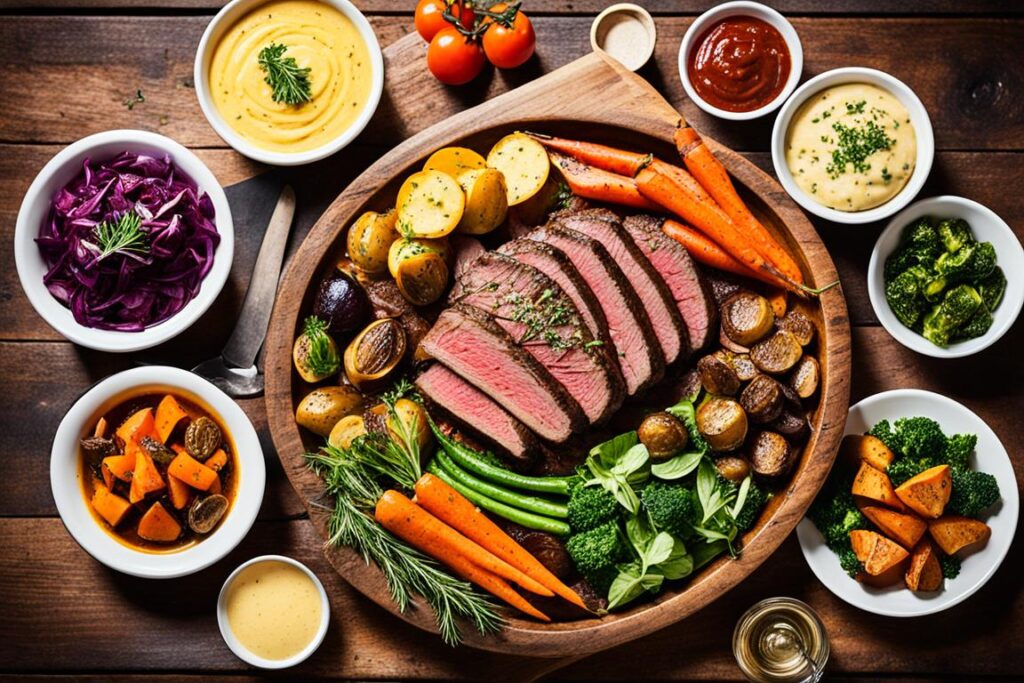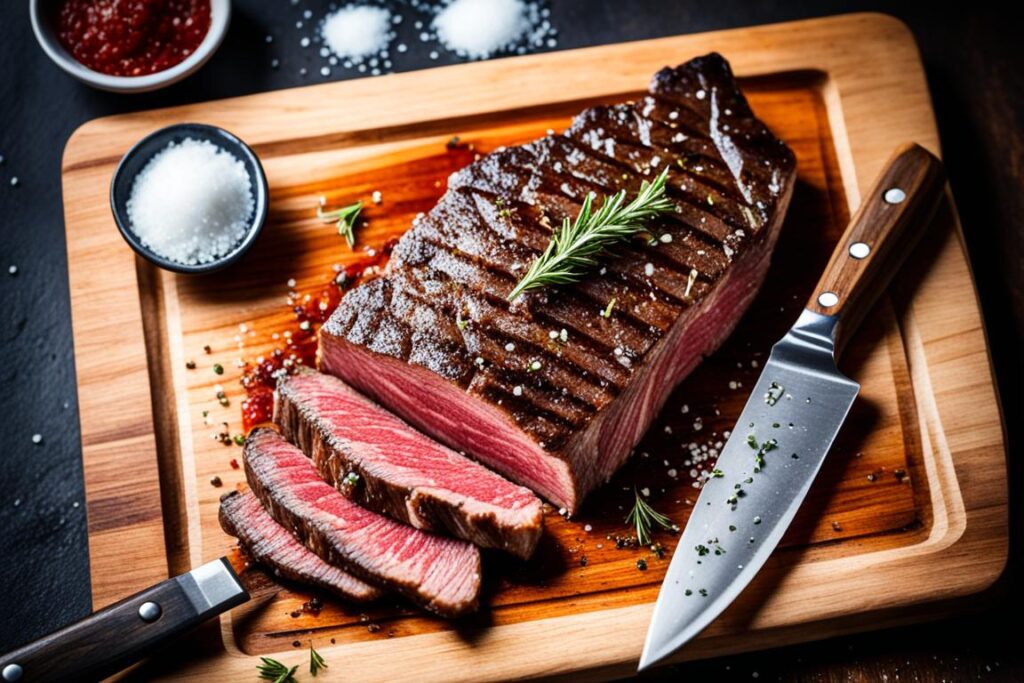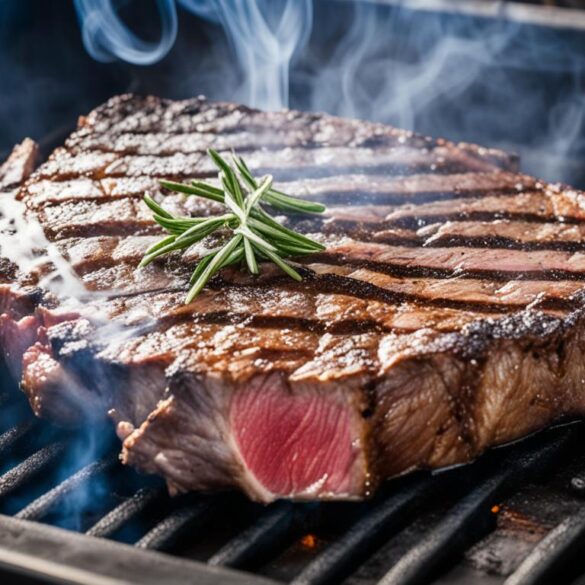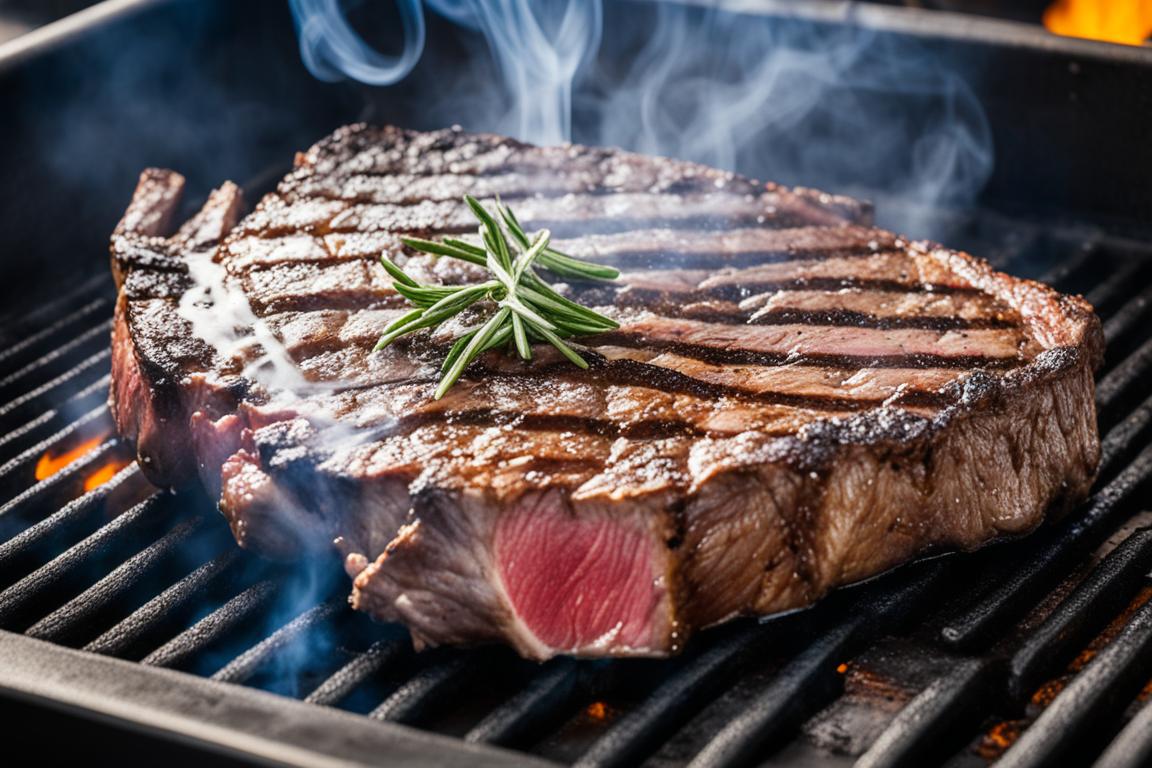The bavette steak is a hidden gem in the world of beef cuts. Known as the butcher’s steak, it’s a favorite among gourmet cooking fans. It’s also a key item on steakhouse favorite menus. This cut is loved for its rich flavor and versatility, making it great for cooking at home.
This steak comes from French culinary traditions but is now popular in American kitchens too. Whether you’re grilling it or marinating it, the bavette steak is sure to impress. It’s perfect for both new and experienced cooks.
Key Takeaways
- Bavette steak is an under-appreciated cut with rich flavor.
- It is often called the butcher’s steak and popular in steakhouses.
- Known for its versatility, it can be grilled, pan-seared, or cooked on a cast iron skillet.
- Ideal for home cooking and exploring different beef cuts.
- Gaining popularity in American gourmet cooking circles.
What is Bavette Steak?
Bavette steak is a favorite among beef lovers. It comes from the lower chest or belly of the cow. Known for its rich taste and tender feel, it’s a special cut.
Origin of Bavette Steak
This steak comes from traditional French cooking, often seen in bistro dishes. French butchers have perfected this cut, making it a hit with food lovers. The name “bavette” means “bib” in French, which suits the steak’s meaty flap.
Characteristics of Bavette Steak
Bavette steak is known for its unique grain and lots of marbling. This makes it taste robust and tender. It’s perfect for many cooking methods that bring out its juices.
When cut right, you see its beautiful marbled inside. This shows the quality fat that makes it so tasty.
Comparison with Other Cuts
When comparing Bavette to other cuts like flank steak and flat iron steak, its qualities stand out. It’s more flavorful than flank steak and juicier. Flat iron steak is tender but doesn’t match Bavette’s rich taste.
Choosing between these cuts depends on what you like and the meal you want to make.
The Best Ways to Cook Bavette Steak
The bavette steak is a flavorful cut of meat. It can be cooked in different ways to make it tender and rich. We’ll look at three great methods: grilling, pan-searing, and using a cast iron skillet.
Grilling Bavette Steak
Grilling gives the bavette steak a nice char and smoky flavor. First, heat your grill to high. Season the steak with salt and pepper or your favorite rub. Then, put the steak on the grill and cook for 4-5 minutes on each side.
This time may change based on the steak’s thickness and how well done you like it. Let the steak rest for 5 minutes before slicing. This helps the juices spread evenly.
Pan-searing Bavette Steak
Pan-searing creates a great crust on your bavette steak. Start by heating a heavy skillet over medium-high heat. Use oil with a high smoke point, like canola or avocado oil.
Once the oil is hot, put the steak in the skillet. Cook for 3-4 minutes on each side for a good sear. Keep an eye on the heat to prevent burning. For more tips, check out Bon Appétit or other trusted sources.
Using a Cast Iron Skillet
A cast iron skillet is perfect for cooking bavette steak because of its even heat. Heat the skillet over medium-high until it’s very hot. Add a bit of oil, then the steak.
Sear each side for 3-4 minutes. Then, lower the heat to medium and cook until the steak is done to your liking. A cast iron skillet helps cook the steak evenly and gives it a tasty crust. For more advice, see Foothills Local Meats.
Marinating Bavette Steak for Extra Flavor
Marinating bavette steak is a great way to add amazing flavor. The right marinade makes the meat tender and adds aromatic notes. This turns each bite into a special treat.
The Best Marinade Recipes
When picking a marinade, mix acidity, sweetness, and spices well. Here are some top recipes:
- Balsamic and Herb Marinade: A blend of balsamic vinegar, olive oil, garlic, and fresh herbs that brings out rich, savory dishes.
- Teriyaki Marinade: A classic mix of soy sauce, ginger, garlic, and honey for an umami-packed flavor infusion.
- Chimichurri Marinade: A zesty combination of parsley, garlic, vinegar, and red pepper flakes, perfect for adding a tangy twist.
How Long Should You Marinate?
Marinating times are key for the right flavor and tenderness. Here’s a quick guide:
- Quick flavor infusion: Marinate for 30 minutes to 1 hour for a light seasoning, ideal for weeknight meals.
- Medium flavor penetration: Marinate for 2 to 4 hours to balance tenderness and rich flavors, suitable for small gatherings.
- Deep flavor absorption: Marinate overnight up to 24 hours for intense, savory dishes that are perfect for special occasions.
Marinating Tips and Tricks
Getting better at marinating can boost your cooking. Here are some expert tips:
- Use fresh ingredients: Fresh herbs and spices make flavors more vibrant.
- Balance acidity: Acids like vinegar or citrus juice tenderize but can be too much. Find a good balance.
- Avoid metal containers: Use plastic bags or glass containers as metals can change the taste of your meat.
Grilling Tips for Bavette Steak
Grilling bavette steak is fun for outdoor cooking lovers. With the right methods, you can make a juicy and tasty steak every time. Here are some key tips to help you.
Choosing the Right Grill
Choosing the right grill is important for grilling bavette steak. You can pick between a charcoal or gas grill, each with its own perks. Weber Grills says charcoal grills give a rich, smoky taste that many love. Gas grills are great for their ease and precise temperature control.
Grill Temperature and Time
Getting the grill temperature and timing right is crucial for a perfect steak. Heat it up to medium-high for bavette steak. Kingsford suggests grilling it for 4-6 minutes per side, based on how done you like it. A meat thermometer is handy for checking the internal temperature to get it just right.
For more tasty beef recipes, including shaved beef, check out this link for some great ideas.
Tenderizing Bavette Steak: Techniques That Work
Getting the meat tenderness right in bavette steak is key for a great meal. We’ll look at top ways to make it tender, so your kitchen feels like a fancy restaurant.
Physical Tenderizing Methods
Scoring and pounding are top choices for making bavette steak tender. Use a meat mallet to pound it softly, which breaks down the fibers. Also, make shallow cuts on the surface to soak up marinades and seasonings better.
Using Marinades for Tenderizing
Marinating is another way to make meat tender. Use marinades with natural enzymes like pineapple, papaya, and yogurt. These enzymes work on muscle proteins, making the steak soft and tasty. Make sure to marinate for 30 minutes to 24 hours to avoid over-doing it.
Resting the Steak
Letting the steak rest is a crucial step in home cooking. After cooking, let the bavette steak rest for 10 minutes. This lets the juices spread out, making the meat juicy and full of flavor. Using these simple culinary techniques ensures tender meat and takes your bavette steak to new heights.
Perfect Sides to Complement Bavette Steak
Choosing the right side dishes can make bavette steak a complete meal. It adds to the dining experience with balanced flavors. Let’s look at some side options that go well with this tasty meat.

Grilled Vegetables
Grilled vegetables bring a smoky taste to your bavette steak. Try using zucchini, asparagus, and bell peppers. Brush them with olive oil and season with herbs for a great match.
This makes your plate colorful and your taste buds happy.
Classic Potato Dishes
Potato dishes are great sides that bring comfort. You can have crispy roasted potatoes, creamy mashed potatoes, or classic French fries. These sides go well with the juicy bavette steak, making your meal feel complete.
Fresh Salads
A fresh salad is a perfect side to balance the richness of bavette steak. Consider a light arugula salad with lemon vinaigrette or a hearty Caesar salad. The crispness and acidity of fresh greens clean your palate.
They also make your meal more rounded and healthy.
Bavette Steak vs Flank Steak
Choosing between bavette steak and flank steak is key for food lovers. Each cut has its own taste and texture. These differences can change how you enjoy your meals and help you make healthier choices.
Differences in Flavor and Texture
Bavette steak is famous for its deep beef taste and soft texture. It soaks up marinades well. Flank steak, on the other hand, is chewier and has a stronger flavor. Knowing these differences helps food lovers pick the best cut for their dishes.
For example, to try out this tasty recipe, understanding these differences is key.
Cooking Techniques Comparison
Bavette steak is great for grilling or pan-searing because it stays juicy. Flank steak works well with slow cooking or broiling. Both can be seasoned and marinated, but bavette is best with quick, high-heat cooking to stay tender.
Nutritional Comparison
For those choosing healthy options, both bavette and flank steaks are lean beef cuts. Bavette has more calories because of its marbling. But flank steak is leaner with fewer calories per serving. Both are packed with protein, which is great for a balanced diet.
Knowing the differences in taste, cooking methods, and nutrition helps food lovers pick the best between bavette and flank steaks.
Where to Buy Bavette Steak
Looking for bavette steak? This shopping guide will help you find the best places to buy. You can check online, visit local butchers, or go to farmers markets.

Online Retailers
Buying bavette steak online is easy and convenient. Online retailers have a wide selection. You can compare prices and read reviews before you buy.
They also share info about where the beef comes from. This ensures you get high-quality, locally sourced meat at your doorstep.
Local Butchers
If you like a personal touch, try a local butcher. They offer custom cuts and expert advice on cooking bavette steak. You’re likely to find locally sourced beef that’s fresh.
Don’t forget to ask about the meat’s origin and any special cooking tips.
Farmers Markets
Farmers markets are great for finding bavette steak. They sell organic and sustainably raised beef from local farms. Shopping here supports local farmers and lets you talk to them directly.
You’ll learn about the animals’ living conditions and what they eat. This ensures you get top-quality beef that meets your standards.
Healthy Recipes Using Bavette Steak
Bavette steak can be the star of many nutritious meals. It fits into different dietary preferences. This section offers recipes for a low-carb salad, a vibrant stir-fry, and tasty tacos. These recipes make for a delightful mix of taste and health benefits in your meal planning.
Low-Carb Bavette Steak Salad
A low-carb bavette steak salad is great for a light yet fulfilling meal. It combines the steak’s flavors with fresh greens, cherry tomatoes, and a tangy dressing. It’s perfect for those on keto or paleo diets.
Bavette Steak Stir-fry
This stir-fry is a quick way to add bavette steak to your meal planning. It’s full of colorful veggies like bell peppers, broccoli, and snap peas. The dish is both nutritious and looks great on a plate. The steak absorbs the rich flavors of the sauce, making it a balanced meal.
Bavette Steak Tacos
Bavette steak tacos offer a healthier twist on a classic dish. Use whole grain or low-carb tortillas and fill them with the steak, avocado, cilantro, and lime. These tacos are tasty and fit into various dietary preferences. They’re a great choice for any meal planning routine.
Common Mistakes to Avoid When Cooking Bavette Steak
Cooking bavette steak can be fun, but don’t let mistakes ruin your meal. Here are some errors to avoid for a perfect dish:
Overcooking is a big mistake with bavette steak. This meat should be cooked to medium-rare at most. It keeps it tender and tasty. Use a meat thermometer for accuracy.
Not letting the steak rest is another mistake. Resting lets juices spread, making each bite juicy and flavorful. Rest your bavette steak for 5-10 minutes after cooking.
Wrong seasoning can also mess up your steak. Bavette steak loves bold flavors. Season both sides with salt, pepper, and your favorite spices before cooking.
- Skipping the marinade is a big no-no. Marinating makes the steak tastier and softer. Try different marinades to find the best one.
- Incorrect slicing can also make the steak tough. Always slice against the grain for tender, easy-to-eat pieces.
Avoid these common mistakes to get better at cooking bavette steak. Follow the best practices for a delicious, tasty steak every time.
Conclusion
We’ve looked into bavette steak and found out about its history, unique traits, and many ways to make it taste great. We learned about its origins and how it compares to other cuts. We also saw the best ways to cook it, like grilling and pan-searing.
Learning how to marinate and tenderize the steak makes it even better. Choosing the right sides can make your meal amazing, whether it’s grilled veggies, classic potatoes, or fresh salads. Knowing the differences between bavette and flank steak helps you pick the best for your meals.
Now, you know where to find bavette steak and how to make healthy recipes with it. Remember these tips to avoid mistakes and have a meal that’s both tasty and memorable. Enjoy cooking with bavette steak and discover new flavors in your dishes.
FAQ
What is Bavette Steak?
Bavette steak, also known as flank steak or butcher’s steak, is a flavorful cut of beef. It’s known for its rich taste and tender texture. It’s a favorite among home cooks who love French cuisine.
How does Bavette Steak compare to other cuts like Flank Steak and Flat Iron Steak?
Bavette steak is often compared to flank and flat iron steaks because of their similar cooking methods and flavors. It has a unique grain and marbling that make it rich and tender. While flank steak is leaner and flat iron steak is slightly more tender, bavette combines the best of both.
What are the best ways to cook Bavette Steak?
You can cook bavette steak by grilling, pan-searing, or using a cast iron skillet. Each method highlights its rich flavor and tender texture. This makes it a versatile choice for any meal.
How long should I marinate Bavette Steak for optimal flavor?
Marinating bavette steak for at least 30 minutes up to 24 hours can greatly improve its flavor and tenderness. A balanced marinade with acid, oil, and seasonings works best.
Are there any tips for grilling Bavette Steak?
When grilling bavette steak, preheat the grill to high heat. Cook the steak for about 4-5 minutes per side for medium-rare. Letting the steak rest for a few minutes after grilling keeps it juicy and flavorful.
What are the effective techniques to tenderize Bavette Steak?
To tenderize bavette steak, use physical methods like scoring and pounding. Marinating with natural tenderizers also helps. Resting the steak after cooking keeps it tender and flavorful.
What side dishes complement Bavette Steak?
Grilled vegetables, classic potato dishes, and fresh salads are great with bavette steak. They balance the steak’s rich flavor, making for a complete meal.
Where can I buy Bavette Steak?
You can buy bavette steak from online retailers, local butchers, and farmers markets. Each place offers different benefits, like convenience, expert advice, and locally sourced options.
What are some healthy recipes using Bavette Steak?
Healthy recipes for bavette steak include a low-carb steak salad, a vibrant stir-fry, and flavorful tacos. These recipes offer nutritious meals for various diets.
What are common mistakes to avoid when cooking Bavette Steak?
Don’t overcook the steak, skip resting it after cooking, and cut against the grain. These mistakes can make the steak tough and less flavorful.

Grilled Bavette Steak
Equipment
- Grill
- Tongs
- Meat Thermometer
Ingredients
Steak
- 1 pound Bavette Steak Choose a well-marbled cut for best flavor.
- 1 teaspoon Salt To taste.
- 1 teaspoon Black Pepper Freshly ground for best flavor.
Instructions
- Preheat the grill to high heat.
- Season the bavette steak with salt and pepper on both sides.
- Place the steak on the grill and cook for 4-5 minutes on each side for medium-rare.
- Use a meat thermometer to check for an internal temperature of 130°F (54°C).
- Remove the steak from the grill and let it rest for 5 minutes before slicing.

